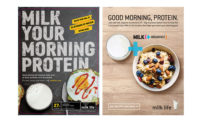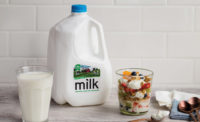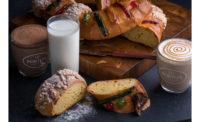Making milk relevant: a Q&A with MilkPEP

MilkPEP CEO Julia Kadison says “We’re working really hard to make sure that we recapture consumers’ attention and keep milk relevant for people of all ages.”

The Milk Life ad campaign promotes the importance of protein in the diet, especially in the morning.


In December, MilkPEP CEO Julia Kadison spoke with Dairy Foodseditor Jim Carper about the challenge to milk from nondairy beverages and her group’s efforts to make milk relevant in U.S. households. The Milk Processor Education Program, Washington, D.C., is funded by the nation’s milk processors.
Kadison was promoted to CEO from vice president of marketing in August 2014. She served as interim CEO following the departure of Vivian Godfrey in November 2013. Since joining MilkPEP in 2006, Kadison spearheaded several marketing campaigns, including Milk Life, which spotlights milk’s high-quality protein and the Great American Milk Drive, which raises awareness of the need for milk donations to food banks across the United States.
Kadison also oversaw the dairy industry’s entrance into the sports recovery market with the Built With Chocolate Milk campaign, which recommends the beverage as a post-exercise drink.
Following is an edited transcript. The entire interview is available as a podcast on dairyfoods.com.
Dairy Foods: MilkPEP has been really busy this past year with new campaigns and commercials, but first let’s talk about milk sales. Can you give me an overview of what happened in 2014 with milk?
Kadison: We’re competing in an increasingly competitive environment and that has been reflected in milk sales. 2014 was the fifth year of decline for fluid milk sales. We’re working really hard to make sure that we recapture consumers’ attention and keep milk relevant for people of all ages.
What’s driving those declines in milk consumption? There are really a lot of variables. We’ve seen a lot of milk alternatives. So people have other choices that they believe — misbelieve I should say — can give them the benefits that they get from milk, whether it’s things like almonds or rice or soy beverages and other ways that they can get calcium and protein.
We also saw the impact of increasing milk prices and a decline in space for milk in the retail category. There are [also] fewer kids in the United States today.
We are very optimistic about the future of milk sales and we really think we are going to start seeing some turn-around in the industry as we head into 2015.
Dairy Foods: What are some of the reasons for optimism?
Kadison: There has been some innovation across the marketplace both in terms of brand innovation, in terms of packaging and messaging. MilkPEP has introduced a few new consumer-related programs into the marketplace, and what we’ve done is take a look at what consumers care about and how that relates to milk. The work that we’re doing is really related to protein.
We know that consumers want and expect options and while milk has been out-innovated by impostors, we’ve done a lot to start to alter our consumers’ opinions and help them to understand why milk is the better choice. We’re going to continue to elevate milk’s benefits to be more relevant in terms of the reasons to believe which includes protein, and also the emotional hook.
The other reason I feel very optimistic is because I believe that more than ever before, the dairy industry is working in concert. We have a new energy between the farmers, the processors, the retailers. We’ve really united to understand and tackle that reverse in the sales trends.
We’re all elevating to a more emotional resonance with consumers. We know that consumers care about community, sustainability and so we’re all working together in those respects as well in tieing milk into those things that consumers care about.
Milk Life is a new campaign that features some stunning visuals of milk and really makes milk the hero. The commercials and the print ads and the work that we are doing in digital and social media really show the importance of how starting the day with milk’s protein can help everybody accomplish what they need to get done that day or really what they want to get done in life.
Americans tend to back load their protein at the end of the day. Our campaigns talk about starting your day with the power of protein and we think that that is a great way to reach consumers and make sure that they are understanding the need for milk in the morning.
Dairy Foods: Is this more educational about milk’s role in protein or are you trying to increase sales of milk through Milk Life?
Kadison: It really does both. We have a two-pronged strategy. We want to increase milk sales of course. We also are working hard to really shore up consumers’ attitudes about milk. Some of the negative attitudes about milk have actually been increasing among consumers. We’re going to be working hard and even more aggressively to come out against the milk naysayers.
We need to get more aggressive against those negative headlines and against the anti-dairy sentiment that seems to be increasing in the marketplace. [Editor’s note: At the Dairy Forum on Jan. 27, Kadison announced a social media campaign which she said will correct misinformation and will communicate the unique nutrient contributions and health benefits of milk. The effort will be supported with a website (MilkTruth.com), where consumers will find research that supports the nutrition in milk.]
Dairy Foods: What can an individual milk processor do to leverage the research on insights that you’ve developed? How can a dairy take that information and apply it to its own milk products?
Kadison: The first one is to really acquaint themselves with the research and we have an entire research library that is available to processors on our website, milkpep.org. There are some easy things that processors can do, like talk more about protein in their messaging. Protein messaging on their packaging is another thing that they can do.
MilkPEP puts together any number of content pieces for processors to share out through their websites and their social channels. We’re going to be turning out a lot more content and we are going to make it really easy for processors to use through their own channels. They can even customize it for their own brand.
Dairy Foods: MilkPEP has done a lot of research into chocolate milk and its role as an exercise recovery beverage. What can you tell me about the results from that campaign?
Kadison: We’re really thrilled to see that the awareness of the Built with Chocolate Milk campaign is really strong and we see it growing. We see that that campaign is really getting to the target: adult athletes. We are focusing on continuing that momentum into 2015.
Dairy Foods: You enlisted the Olympian Apolo Ohno and he was training for the Iron Man Triathlon and recovering with chocolate milk throughout his training.
Kadison: Not only did he go from being a short track athlete to an endurance athlete, he lost a lot of weight in the process. He was just a joy to work with and he did really well in the triathlon. He brought a lot of attention to the campaign and to chocolate milk.
Dairy Foods: I think it’s something that even weekend warriors can aspire to. Even if you’re not an elite triathlete you can still have some chocolate milk after you hit the treadmill, or the tennis courts or the lap pool.
Kadison: That brings up a good point. You don’t have to be a gold medalist and you don’t have to be an Iron Man world champion to get the benefits from chocolate milk. This is for all of us. If you go out and you do a tough workout, drink chocolate milk when you get finished and you’re going to feel it immediately.
Dairy Foods: A third big initiative for MilkPEP in 2014 was the Great American Milk Drive where you helped get fresh milk into the homes of America’s neediest families.
Kadison: Today we’ve had about 220,000 gallons of milk donated by consumers and by the industry and so we are really pleased with that. I have to say Feeding America has been a great partner. They are really appreciative because while donations are top of mind for a lot of consumers, everyone knows that there is an increasing number of hungry families in their communities.
Beyond donations, what The Great American Milk Drive has been so successful at is it’s making American consumers, whether they donate or not, feel better about milk and it makes them feel better about the dairy industry.
Dairy Foods: We’ve talked a little bit about some of your initiatives for 2015 but let’s do a deeper dive into what your plans are in terms of research, investments, partnerships and other campaigns.
Kadison: We are working jointly with milk processors and others in the industry including farmers and retailers to understand and tackle those obstacles that are facing the industry.
We’re doing some research right now to really understand what are the drivers behind this erosion in milk attitudes among consumers. Once we learn that, we can build those into our messaging and into our program.
We’re also using partnerships in a way that it’s so impactful, including one with Quaker Oats. We brought together two amazing equities: the milk mustache and Larry the Quaker man. We put Larry in a milk mustache and we [asked] consumers to make their oatmeal with milk. It makes it more nutritious and it gives them that protein boost in the morning.
Dairy Foods: It sounds like MilkPEP has a full plate and you’re staying relevant for milk processors and for the milk category and in the health and nutrition space.
Kadison: We have a long-term strategy and we’re really sticking with it, but we also know that we have to be flexible and really act with urgency. The milk industry is in a bad way right now and five years of decline is something that we are feeling. Certainly our processors are feeling it out in the marketplace.
Each of our campaigns is really focused on driving that milk consumption and changing consumer behavior. It’s so important that we rebuild consumer confidence in milk and their love of milk. Make sure that they remember that, how good it tastes and how important it is in their lives. Of course, we can’t do it alone. We are really activating the industry to work hand-in-hand.
Looking for a reprint of this article?
From high-res PDFs to custom plaques, order your copy today!







